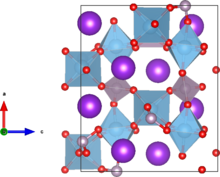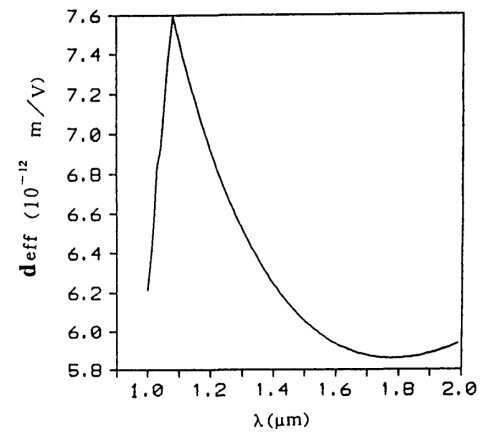Home > NLO Crystals >> KTP
KTP Crystals & Applications
KTP is one of the most frequently used non-linear optical crystals for second harmonic generation (SHG) in medium to low power Nd:Lasers, particularly in diode-pumped solid-state lasers like Nd:YVO4, where itis put in the cavity to produce green lasers. The extensive application of KTP is due to its high conversion efficiency, non-hygroscopic nature, and cost-effectiveness. Furthermore, KTP is also used in 1064nm pumped optical parametric oscillators (OPOs) to produce infrared lasers.
Article Contents:
2. Properties of KTP crystal
3. Features of KTP crystal
4. KTP crystal application examples
5. Order KTP crystal.
1. Historical background of KTP crystal
Potassium Titanyl Phosphate (KTP), with the formula K+[TiO]2+PO43−, was first synthesized in 1890 by L. Ouvard. However, it was not until 1976 that Zumsteg, Bierlein and Gier at E.I. DuPont identified the nonlinear optical properties of this crystal.
KTP crystals were grown using both hydrothermal method and flux method. First a solution consisting of titanium dioxide, KH2PO4, and K2HPO4 was sintered at approximately 1300K and melted in a Pt crucible. Following this, KTiOPO4 (KTP) crystals were grown by top seeded solution growth (TSSG) method in an autoclave.
In the flux method either self-flux or K8P6O19–BaF2 (or NaF, KF) was added as flux. In the hydrothermal method, KTP crystal was grown by using crushed flux KTP crystals as nutrients in a 2.0 mol/l K2HPO4 +0.1 mol/l KH2PO4 +1 wt% H2O2 solution.
It's reported that KTP crystals grown using the hydrothermal method exhibit a higher damage threshold.
KTP crystal structure:
KTP exhibits an orthorhombic crystal structure characterized by octahedral sites occupied by titanium (Ti(IV)) and tetrahedral sites filled with phosphate ions. The coordination number for potassium is markedly high. All heavy elements, namely titanium, phosphorus, and potassium, are exclusively bonded through oxide links, which serve to effectively interconnect these atoms.

Periodically poled potassium titanyl phosphate (PPKTP)
Periodically poled potassium titanyl phosphate (PPKTP) consists of KTP with switching domain regions within the crystal for phase matching. It can be wavelength tailored for efficient second-harmonic generation, sum-frequency generation, and difference frequency generation. The interactions in PPKTP are based upon quasi-phase-matching, which is accomplished through periodic poling of the crystal. This process results in the formation of a structure comprised of uniformly spaced ferroelectric domains with alternating orientations within the material.
PPKTP is commonly used for Type I & II frequency conversions for pump wavelengths of 730–3500nm.
2. Properties of KTP crystal
Crystal Structure:
Orthorhombic, point group mm2Lattice Parameter:
a=6.404, b=10.616, c=12.814, Z=8Melting point:
1172 °C incongruentCurie Point:
936 °CMohs Hardness:
~5Density:
3.01g/cm3Hygroscopic Susceptibility:
noSpecific Heat:
0.1643 cal/g.KThermal Conductivity:
k1= 2.0 k2= 3.0 k3= 3.3 (x10-2 W/cm/°C)Electrical Conductivity:
3.5 x 10E-8s/cm (c-axis, 1KHz)Transparency Range:
350-4500nmSHG Phase Matchable Range:
Fundamental wavelength 994 ~ 2500nm.Hygroscopic Susceptibility:
noThermo-Optic Coefficients:
dnx/dT=1.1x10-5/°C dny/dT=1.3x10-5/°C dnz/dT=1.6x10-5/°CAbsorption Coefficients:
<1%/cm at 1064nm & 532nmAngle Acceptance:
14.2mrad-cm (φ); 55.3mrad-cm (θ)(Type II, SHG@1064nm)Temperature Acceptance:
24°C-cmSpectral Acceptance:
0.56nm-cmWalk-off Angle:
0.55°(Type II SHG@1064nm)NLO Coefficients:
deff(II)=(d24-d15)sin(2φ)sin(2θ)-(d15sin2(φ) + d24cos2(φ))sin(θ)
Non-vanished NLO susceptibilities(pm/V)
:d31=6.5, d32=5, d33=13.7, d24=7.6, d15=6.1
Sellmeier Equations:
(λ = 0.43 - 3.54μm)nx2= 3.29100 + 0.004140/(λ2 - 0.03978) + 9.35522/(λ2 - 31.45571)
ny2= 3.45018 + 0.043341/(λ2 - 0.04597) + 16.98825/(λ2 - 39.43799)
nz2= 4.59423 + 0.06206/(λ2 - 0.04763) + 110.80672/(λ2 - 86.12171)
Electro-optic coefficients:
r13=9.5 r23=15.7 r33=36.3 r51=7.3 r42=9.3pm/V
Half-wave voltage:
~1.8KV (at 1064nm,4*4*20mm3)Resistivity:
>3x107ohm-cm3. Features of KTP crystal
Pros:
High Nonlinearity: KTP has a large nonlinear coefficient deff = 8.3 d36(KDP), making it effective for frequency doubling and other nonlinear applications.
- High Damage Threshold: For bare flux-grown KTP surfaces, the damage threshold is approximately 1.4-2.2 GW/cm² at 532.1 nm and 1.5-2.2 GW/cm² at 1064 nm. For KTP crystal grown by the hydrothermal method, damage threshold of up to 9.5GW/cm2 for 1064 nm (TEM00, 10 ns) was reported(ref. Journal of Crystal Growth Volume 292, Issue 2, 1 July 2006, Pages 364-367).
- Low Temperature Sensitivity: KTP maintains its properties well at varying temperatures, making it suitable for a range of applications.
- Wide Spectral Bandwidth: The KTP had an optical transmission from ~350 nm in the UV to ~4500 nm in the MIR region.
- Good Mechanical Properties: It has a Mohs hardness of about 5, indicating good mechanical strength.
- Cost-effective: Flux-grown KTP crystal is cost-efficient for middle or low power level systems.
- Non-hygroscopic: KTP does not absorb moisture, making it suitable for various environments.
Cons:
- Limited applications: While KTP is effective for SHG, it may not be suitable for all applications due to its specific properties. It is primarily used for Nd:YAG lasers and may not be the best choice for all types of lasers. KTP SHG phase matchable wavelength is limited to 994 ~ 2500nm.
| NLO crystals | KTP |
|---|---|
| Effective NLO Coefficient | 8.3*d36(KDP) or 7.36pm/V |
| Angle Acceptance(mrad-cm)SHG | 14.2mrad-cm (φ); 55.3mrad-cm (θ) |
| Temperature Acceptance(°C-cm) | 24 |
| Spectral Acceptance(nm-cm) | 0.56 |
| Walk-off Angle (degree) | 0.55 |
4. Examples of applications for KTP crystal
SHG of Nd:Laser
- KTP is the most commonly used material for frequency doubling of Nd:YAG and other Nd-doped lasers, particularly when the power density is at a low or medium level. To date, extra- and intra-cavity frequency doubled Nd:lasers using KTP have become a preferred pumping source for visible dye lasers and tunable Ti:Sapphire lasers as well as their amplifiers. 1mW to 3W TEMoo green laser can be generated by intracavity SHG in Nd:YVO4 and Nd:YAG laser.KTP is also being used for intracavity mixing of 0.81µm diode and 1.064µm Nd:YAG laser to generate blue light and intracavity SHG of Nd:YAG or Nd:YAP lasers at 1.3µm to produce red light.

OPO/OPA
- KTP is suitable for Nd:YAG and SHG or Ti:Sapphire Laser pumped OPO/OPA. Pumped by the fundamental and second harmonic of a Nd:YAG or Nd:YLF Laser, KTP's OPO/OPA can generate tunable output in 600-4500nm. NCPM KTP OPO/OPA pumped by the tunable Ti:Sapphire Laser has generated 1.04-1.45μm(signal) and 2.15-3.2μm(idler) with as high as 45% conversion efficiency.E-O Modulator
- KTP is used as E-O modulator in mode-locking diode laser pumped Nd:YAG and Nd:YLF laser as well as Ti:Sapphire and Cr:LiSrAlF6 laser . Due to its higher damage threshold, wide optical bandwidth (>15GHZ), low loss, good thermal and mechanical stability, KTP is expected to replace LiNbO3 crystal in application of E-O modulators.Application for Optical Waveguides
- Based on the ion-exchange process on KTP substrate, KTP optical waveguides have created novel applications in integrated optics. Recently, a type II SHG conversion efficiency of 20%/W/cm2 was achieved by the balanced phase matching, in which the phase mismatch from one section was balanced against a phase mismatch in the opposite sign from the second. Furthermore, segmented KTP waveguides have been applied to the type I quasi-phase-matchable SHG of a tunable Ti:Sapphire laser in the range of 760-960mm, and directly doubled diode lasers for the 400-430nm outputs.5. Order KTP crystal
General specifications of KTP Crystal
Dimension Tolerance:
+0/-0.1mm(WxH), +/-0.1mm thicknessSurface Quality:
10-5 Scratch-digFlatness:
λ/10 @633nmChamfer:
0.1mm@45deg.Clear Aperture:
Central 90% of DiameterParallelism:
<10 arc secondsPerpendicular:
<10 arc minutesOrientation Angle:
+/-0.5deg.Damage Threshold:
5GW/cm2@1064nm 10ns, 25GW/cm2@800nm 10fsCoating:
Dual wavelength AR coating: R<0.2%@ω & R<0.5%@2ω Durability MIL-M-13508, MIL-C-675C, MIL-C-14806, moderate abrasionMost KTP crystals are custom-made, although Optocity does have some KTP crystals in stock. The processing from orientation & cutting to coating typically takes about 3-4 weeks. Stock availability may vary from time to time, please check our sales for detail.